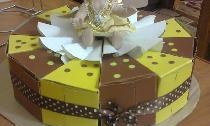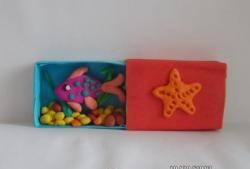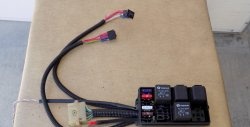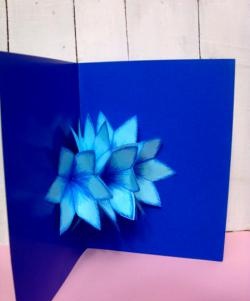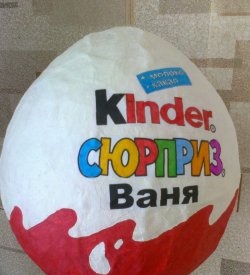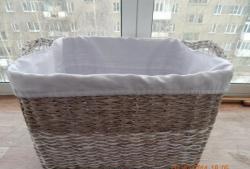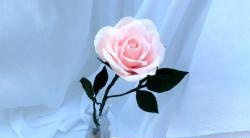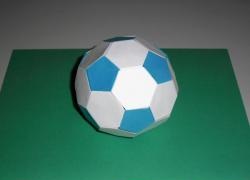Portfolio in a box
Modern society pays close attention to the development and education of the younger generation. It is becoming fashionable not only to be proud of your child’s talents, but also to systematize his achievements, to create folders with documents indicating the child’s movement up the ladder of success. The foreign word “portfolio” is beginning to gain a foothold in everyday speech. There are even competitions in which the portfolio plays a leading role. There are still no standard rules for its design and assembly - you can fantasize and create real masterpieces from scrap materials, emphasizing in every possible way the individuality of the future brilliant designer, or scientist, or writer, or artist...
Materials for work:
• folder - recorder – 1 pc.;
• double-sided colored cardboard – 12 sheets;
• whatman paper in A3 format – 1 sheet;
• PVA glue – 1 pencil;
• old box larger than the recorder – 1 pc.;
• wide stationery tape – 1 roll;
• button on the leg – 1 pc.;
• thin toilet paper – 1 roll;
• notebook with checkered sheets – 1 pc.;
• wide satin ribbon – 1 meter;
• narrow satin ribbon – 15 cm;
• pencil, stapler, paper cutting knife, liquid nails glue, awl, piece of wire, gold paint, curly scissors, brush.
Stages of work:
First stage: create the “face” of the folder.
To create the front side of a portfolio folder, you can use anything: old books, an ABC book, postcards, magazines.
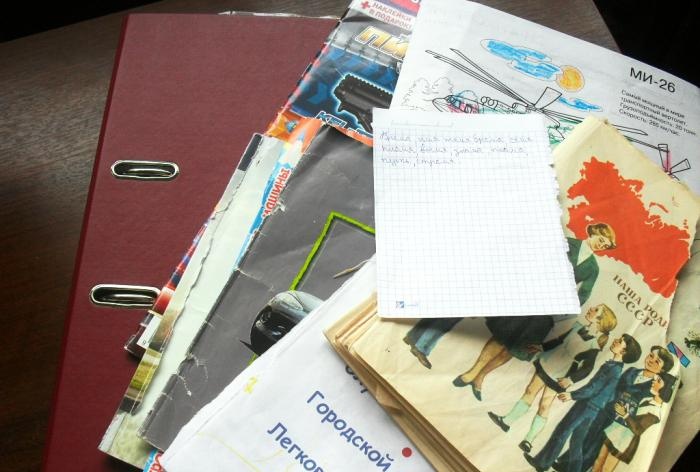
We decorate the edges of the colored sheet with curly scissors. We attach it to the folder with PVA glue.

We glue clippings, pictures, and inscriptions in random order.
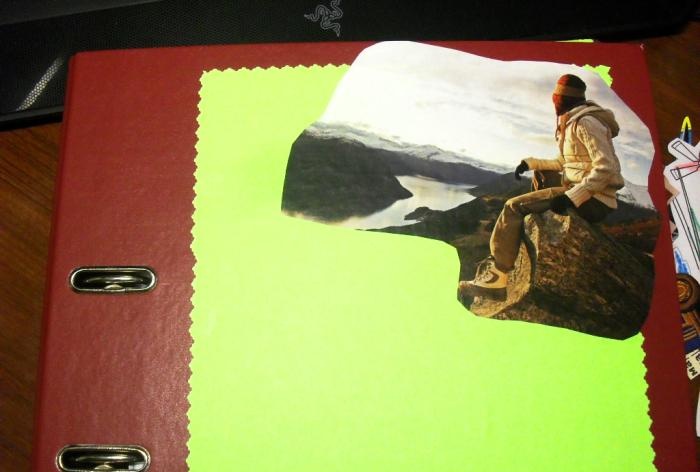
In the central part we write the name of the folder, the last name and first name of its owner.
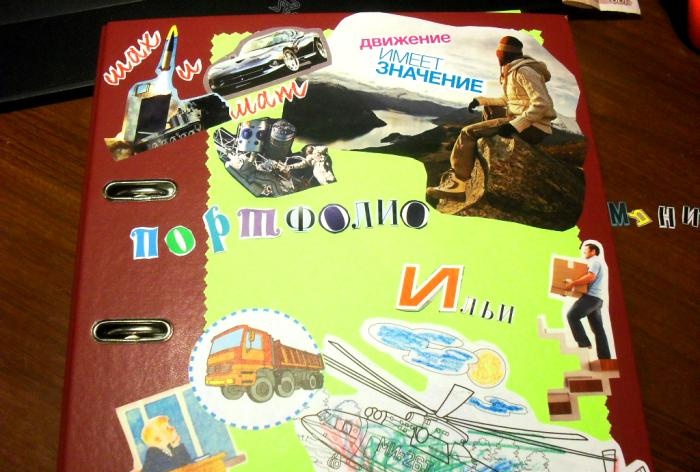
To preserve the integrity of the stickers, the entire collage can be covered with wide tape.
Second stage: we form title pages of sections.
The number of title pages and component sections of the portfolio is not established by certain standards, but to reveal all the child’s potentials, you can create the following: “let’s get acquainted”, “my hobbies”, “my pets”, “I’m in a team”, “my studies”, “documents” ", "my awards", "my works", "my creativity", "my impressions", "reviews", "electronic portfolio". To the back of the recorder folder we glue the “contents” with the names of the sections.
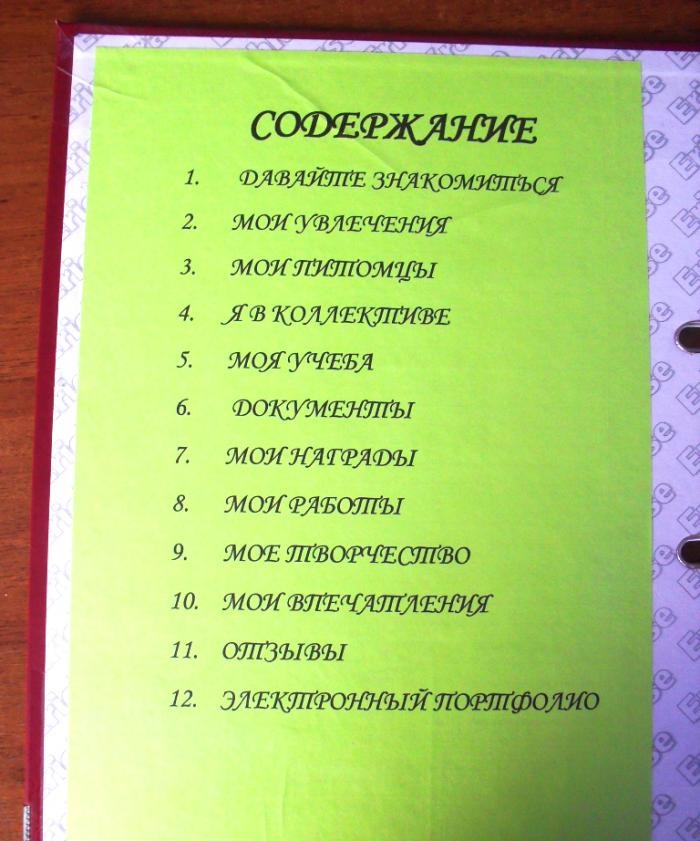
To give uniformity to colored clippings of different sizes that will decorate the title pages of the sections, we tear out the leaves from the notebook and decorate their edges with curly scissors.
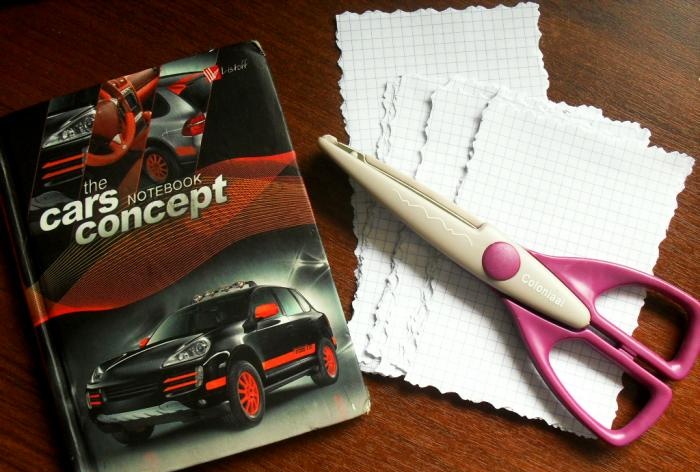
We glue the name of the section onto colored cardboard and decorate it with pictures that match the meaning.
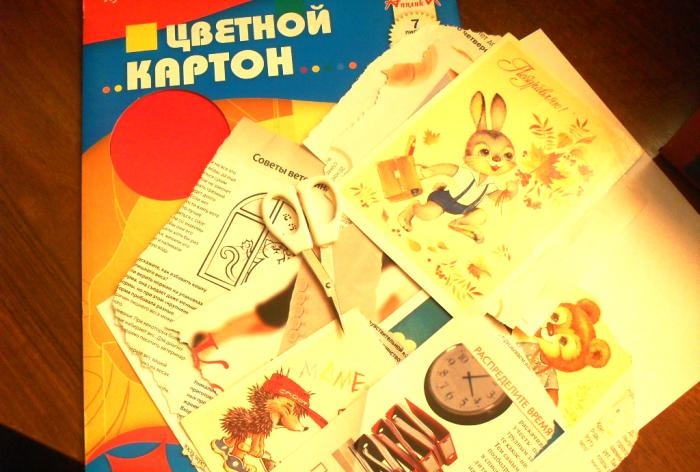
We put the finished title pages into the files.
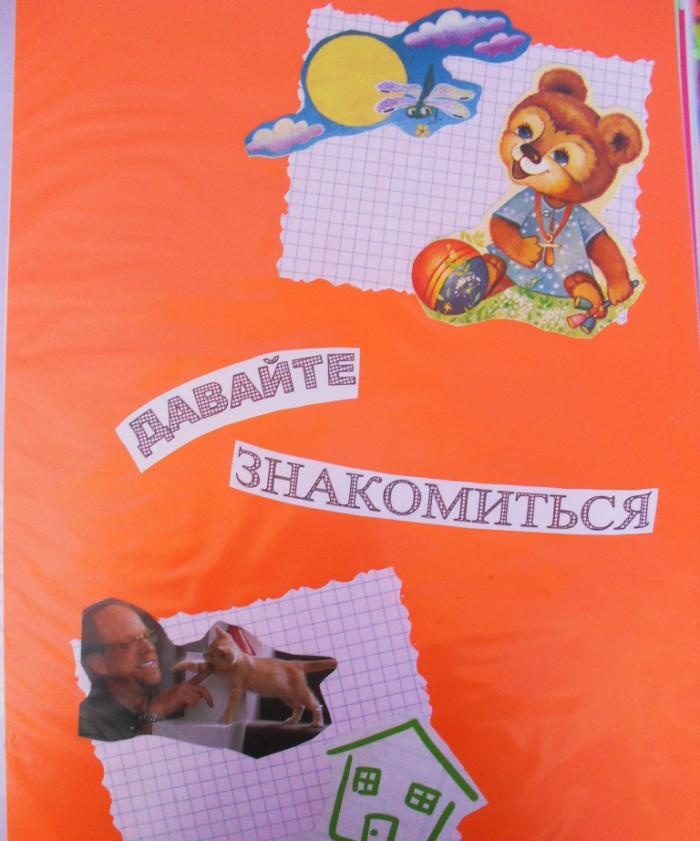
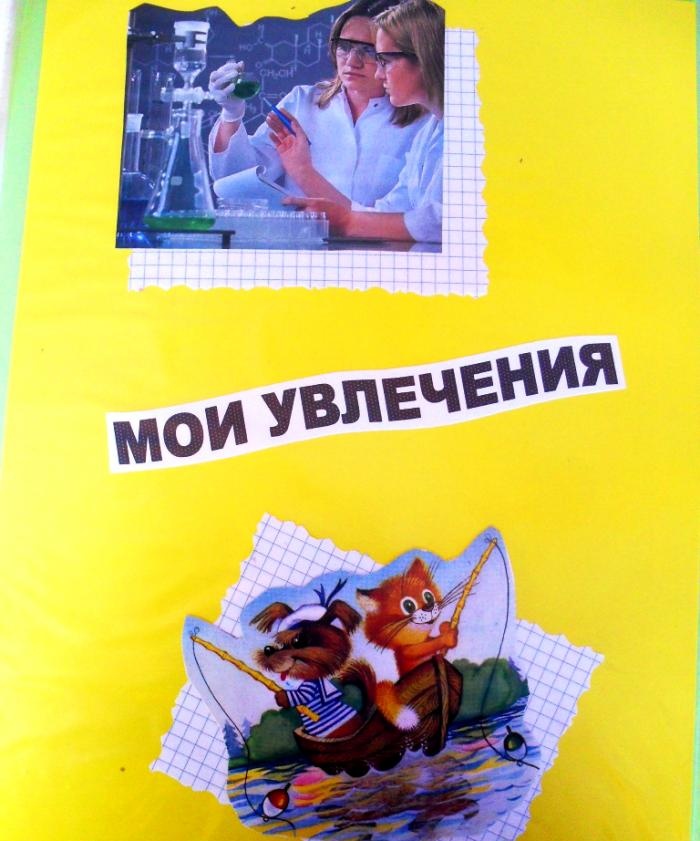
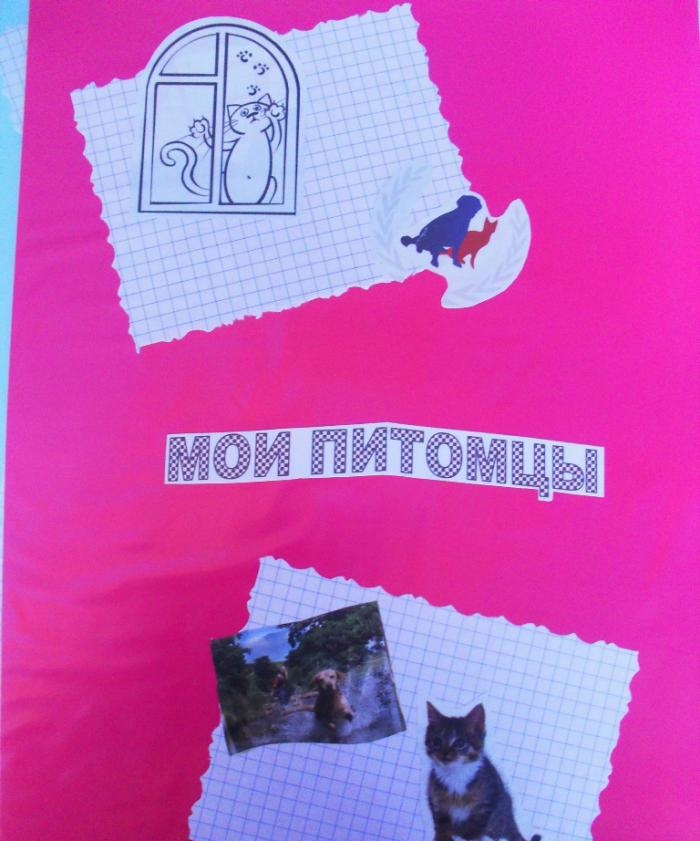

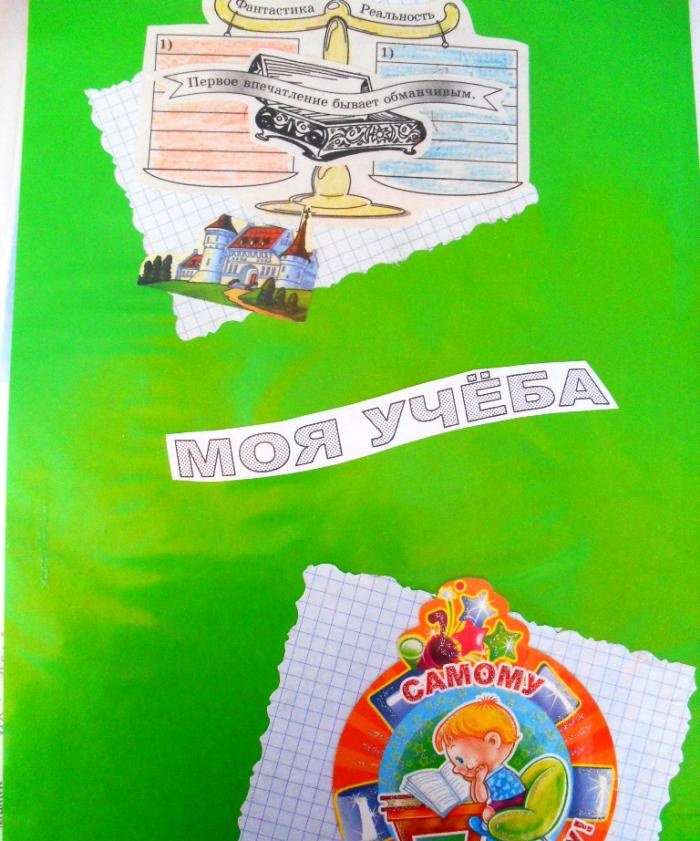
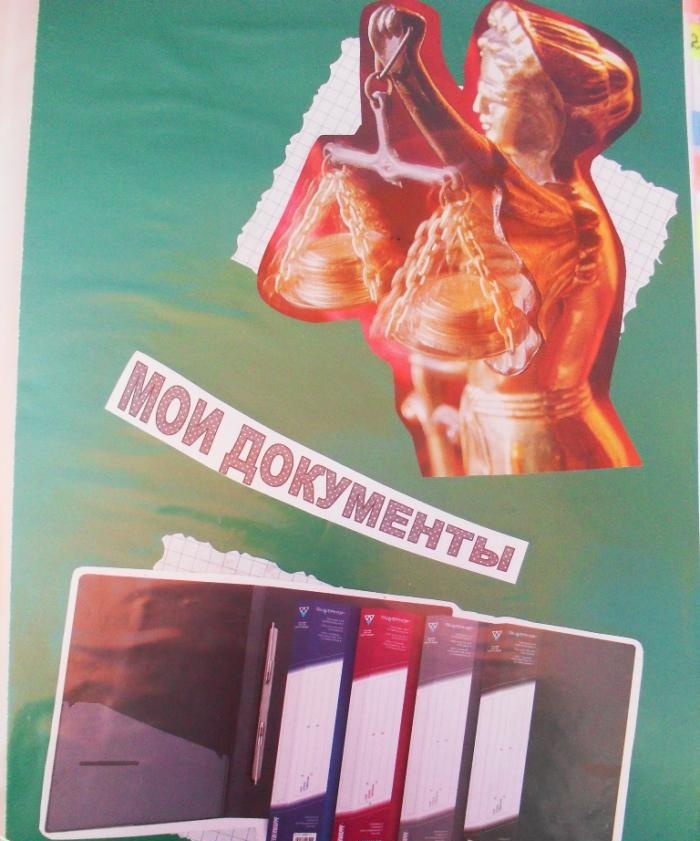
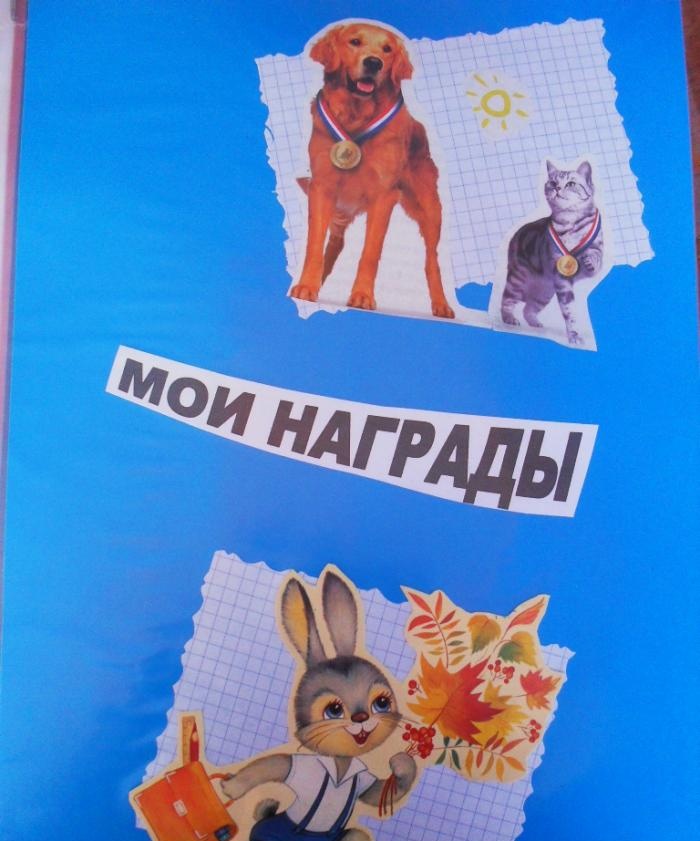
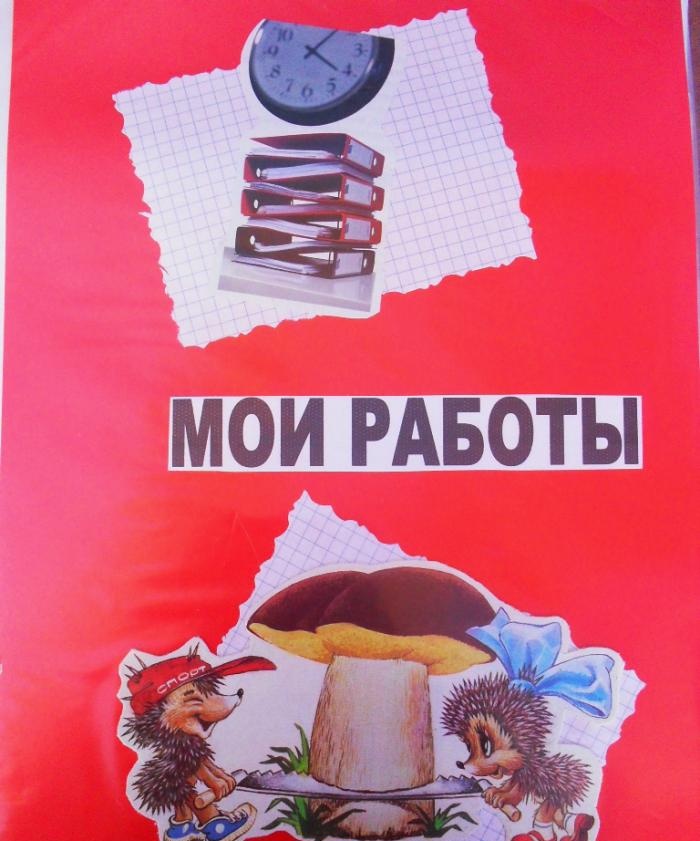
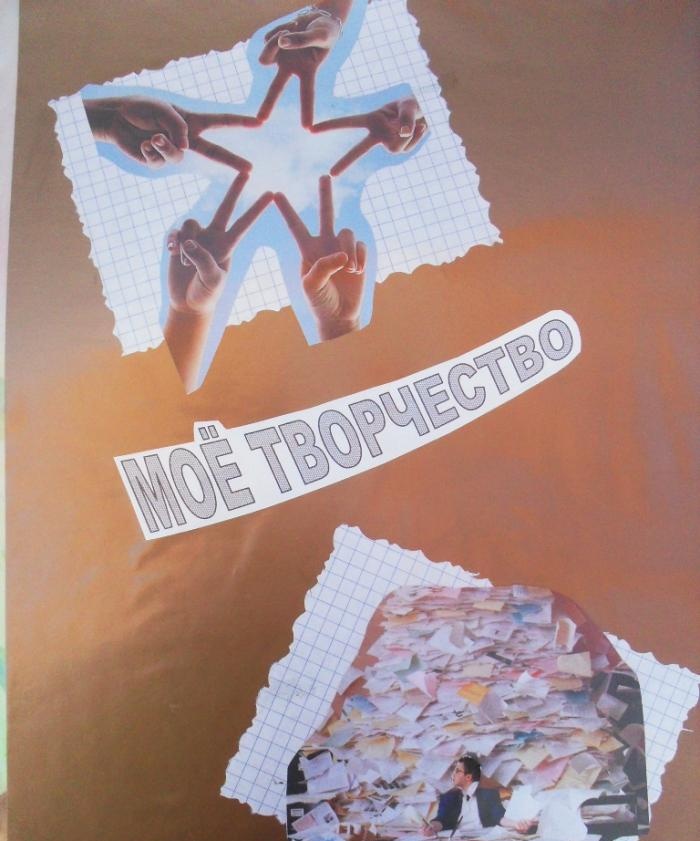
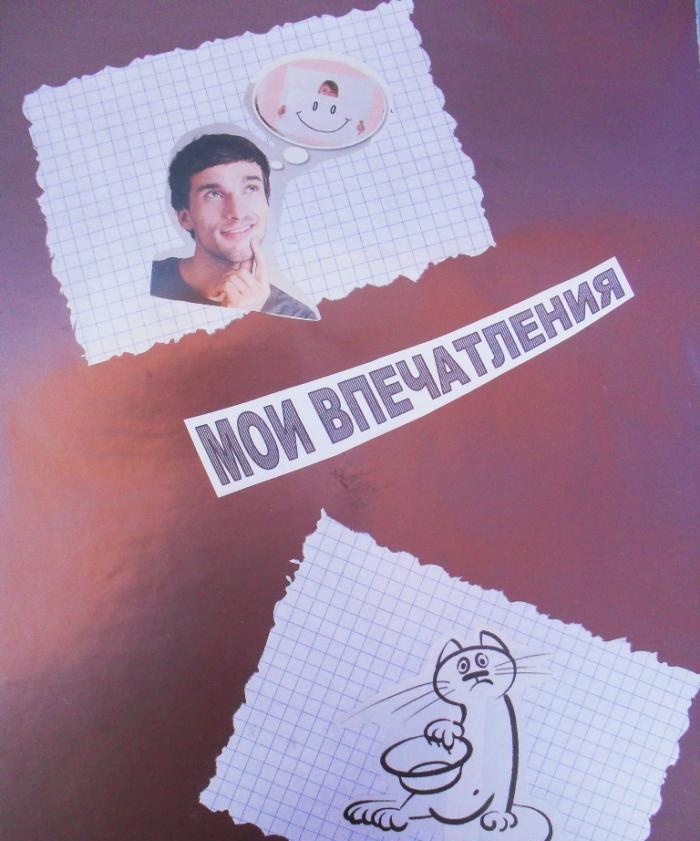
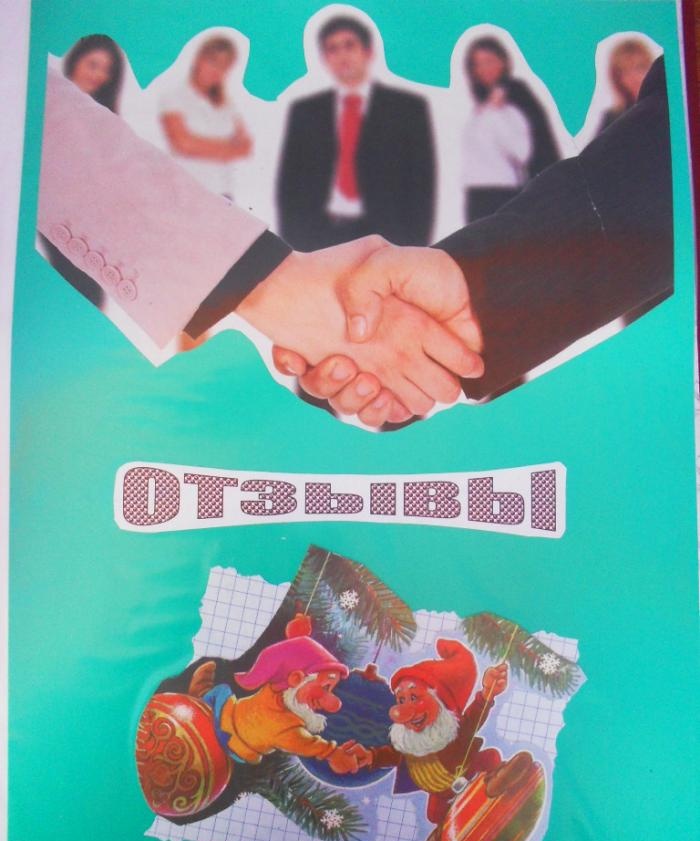
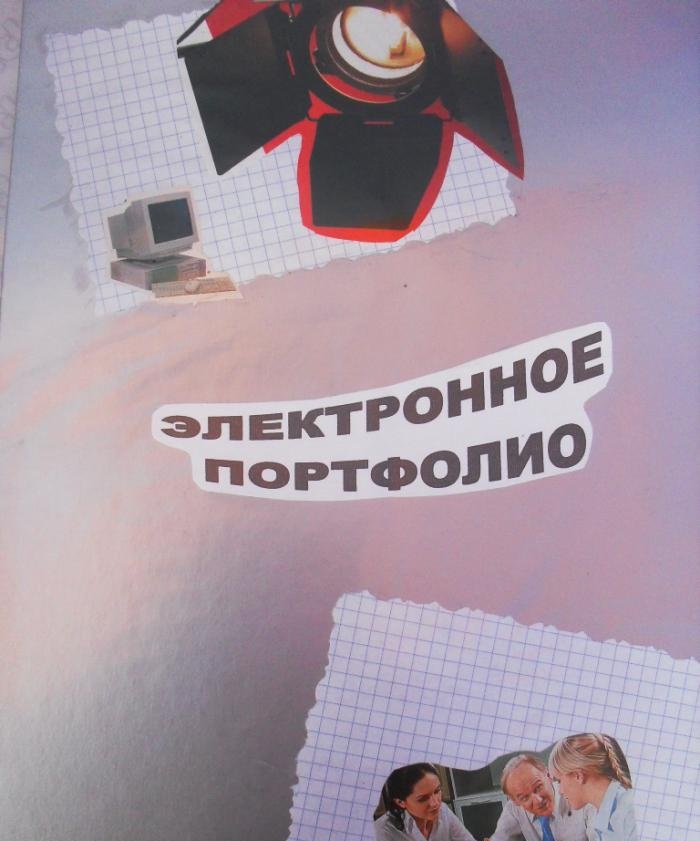
Third stage: make dividing bookmarks.
From whatman paper in A3 format we cut strips 2-3 centimeters wide and a couple of centimeters longer than an A4 sheet.Using a glue cap, we make the cut strips semicircular on one side.
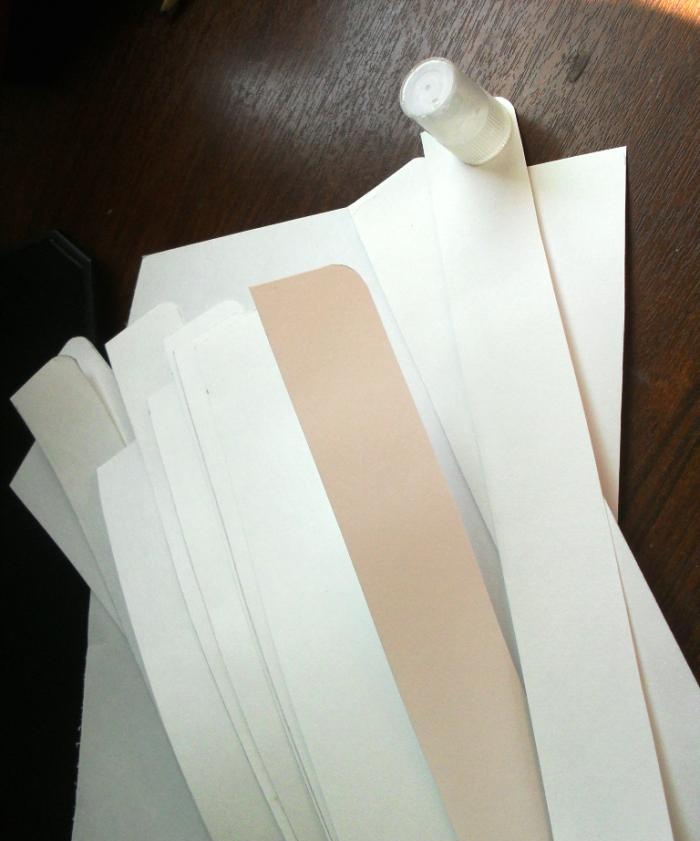
We print out the names of the portfolio sections and cut them.
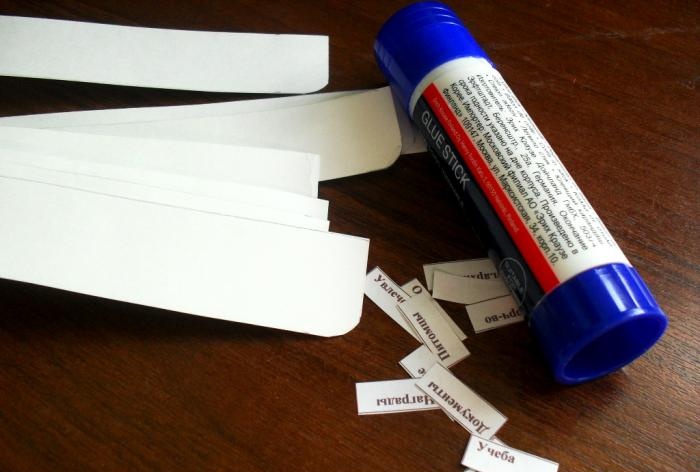
We paste the names of the sections onto long strips.

We seal the names of the sections on the strips with tape on both sides.
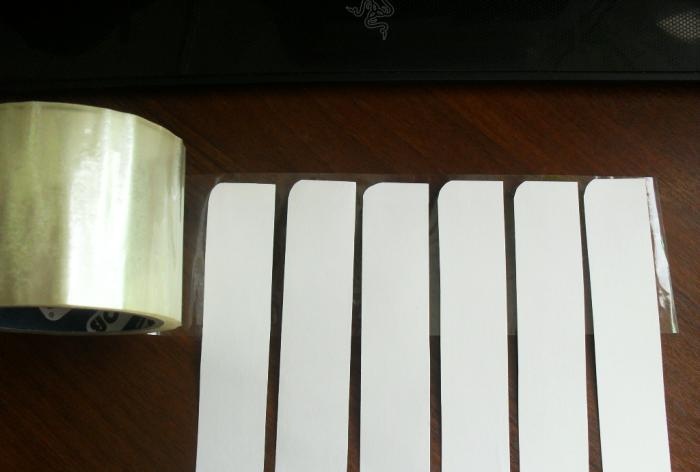
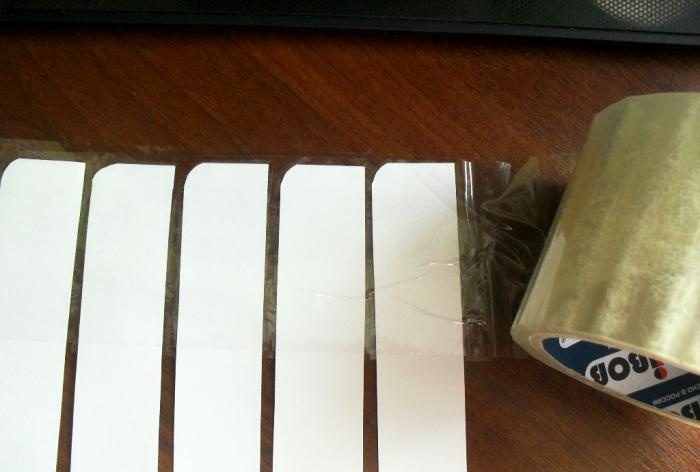
Carefully cut the bookmarks, removing excess tape from the edges.
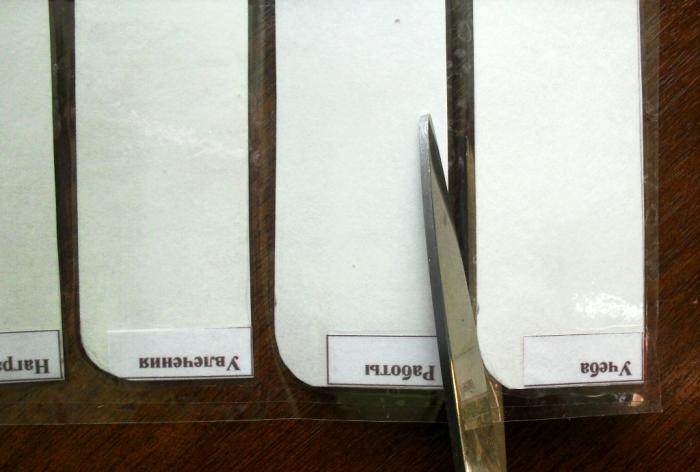
We glue a bookmark to the back side of the title page of the section (with PVA glue).
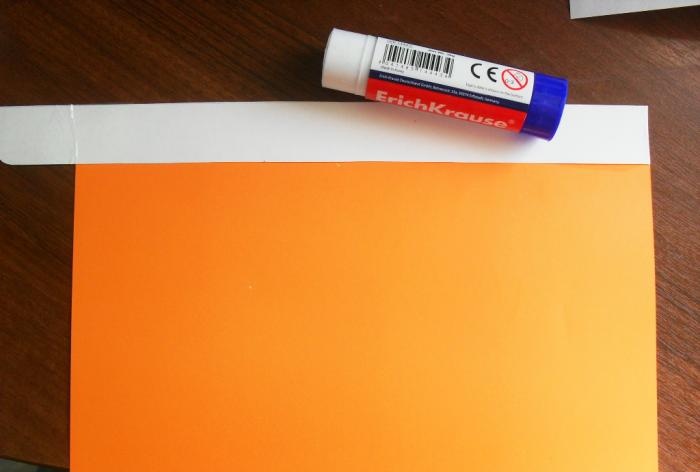
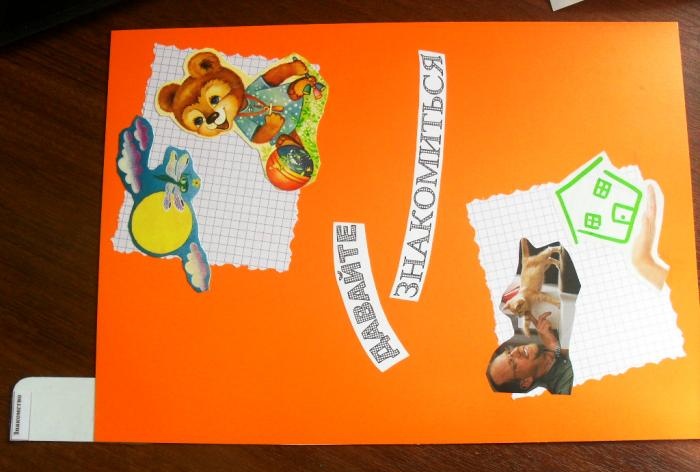
We glue the bookmark to the next title page, slightly shifting it so that it does not fall under the previous one (is not covered by it).
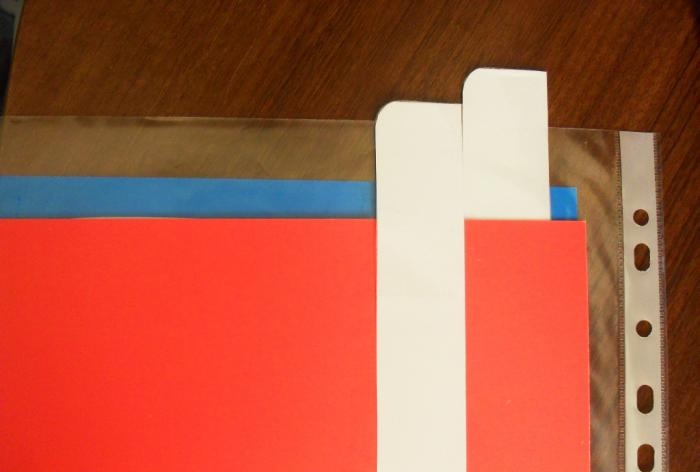
Stage four: systematize the inner world.
We put photos, documents, drawings, works, etc. into files. We insert files under the title page of each section.
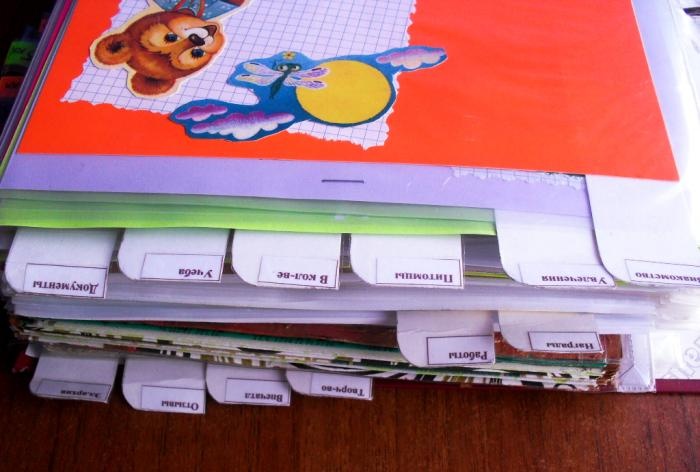
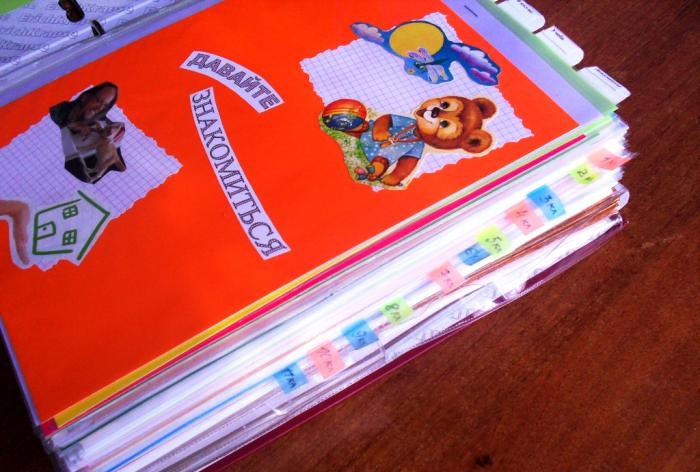
In the “Let’s get to know each other” section, we indicate the child’s full name, date and place of birth, residential address, phone number, school, parents’ full name, and their phone numbers. Accompanying the text with photographs is welcome.
In the “My Hobbies” section, we glue photographs on cardboard sheets that tell about the child’s hobbies. To organize different pictures, you can use decorated leaves of a notepad as a backing for them.
In the “My Pets” section we place the child’s recorded stories about pets and his photographs with them.
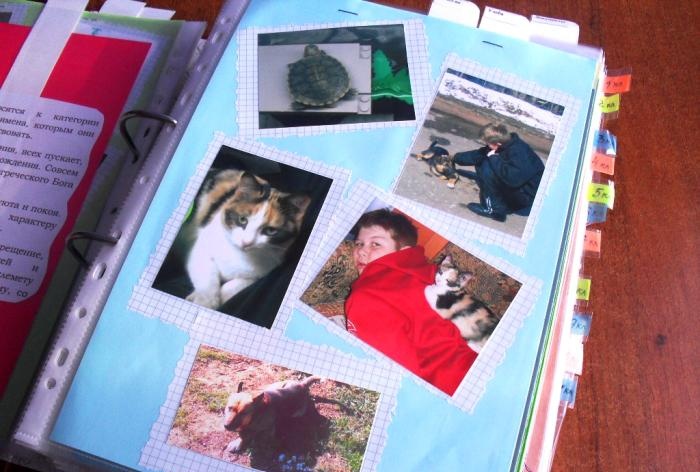
The section “I’m in a team” is formed from cardboard sheets with photographs of the child pasted on them at various school events, hikes, excursions, etc.
The “My studies” section can consist of quarterly and annual grades (taken from diaries), tests and tests given to children.
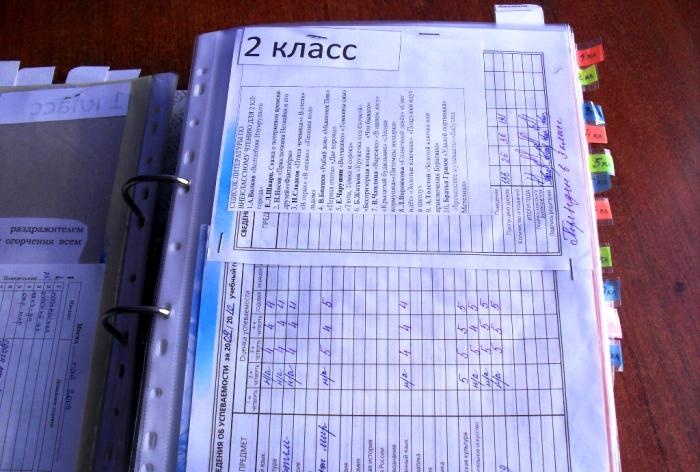
In the “My Documents” section we insert files with diplomas, certificates, and diplomas confirming the child’s participation or victory in Olympiads, competitions, and marathons. You can also place newspaper clippings with articles about your child here.
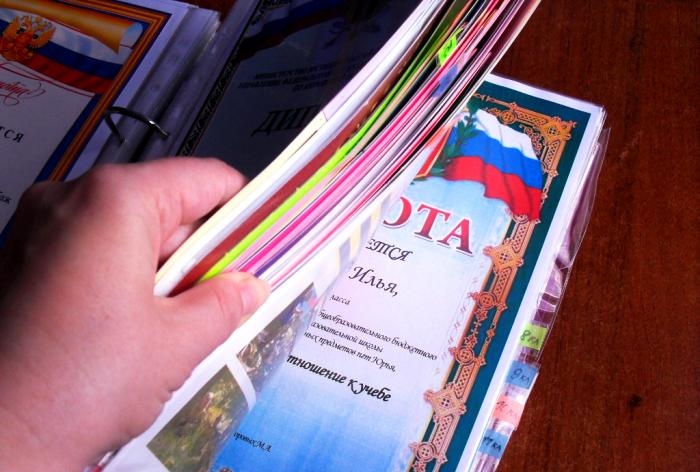
There may not be a “My Awards” section if the child does not have medals, certificates, or certificates. In this section you can place scanned copies of the prizes received (for example, books, pens with the name of the competition, etc.).
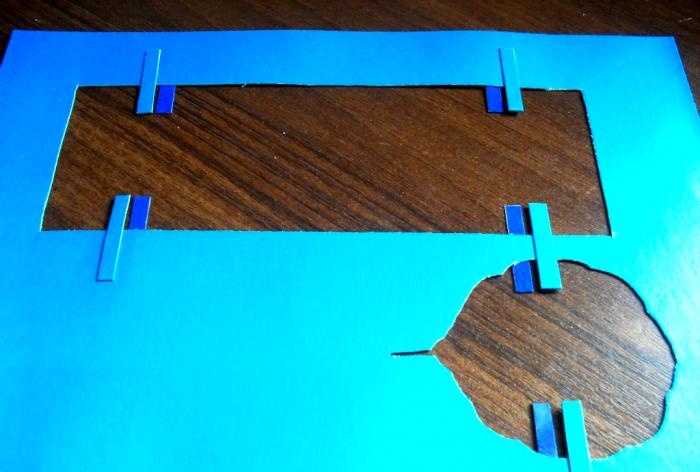
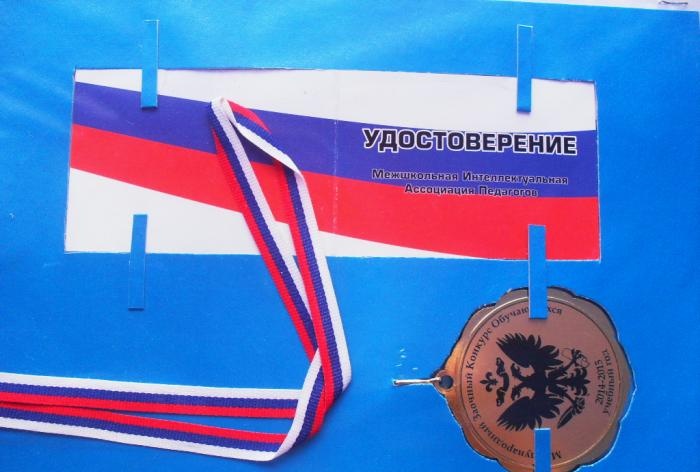
The “My Works” section contains competitive essays, research papers, and archival materials collected for the family.
In the “My Creativity” section we place files with the child’s drawings, scanned copies of his crafts, applications and other leisure activities.
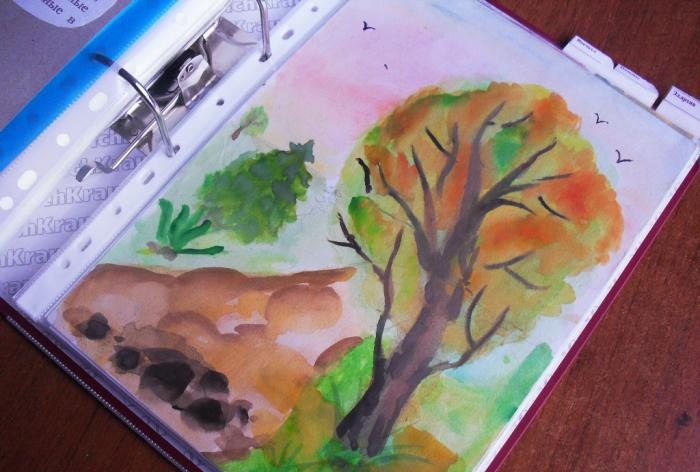
In the “My Impressions” section we put files with the child’s recorded stories about excursions, competitions, and trips.
The “Reviews” section may contain characteristics from the school, various sections and clubs, wishes and recommendations from friends and classmates, trip and expedition leaders.
The “Electronic Portfolio” section includes a flash drive with copies of presentations prepared by the child, photographs of his school and extracurricular life that are not included in the “I’m in a Team” section.
Fifth stage: forming the base.
We take a box larger in size than the folder-recorder.
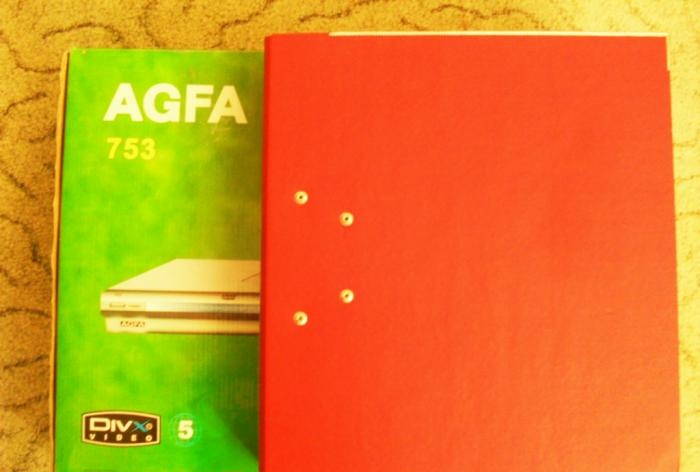
Stepping back a couple of centimeters from the folder, we make a cut to the edges of the box.
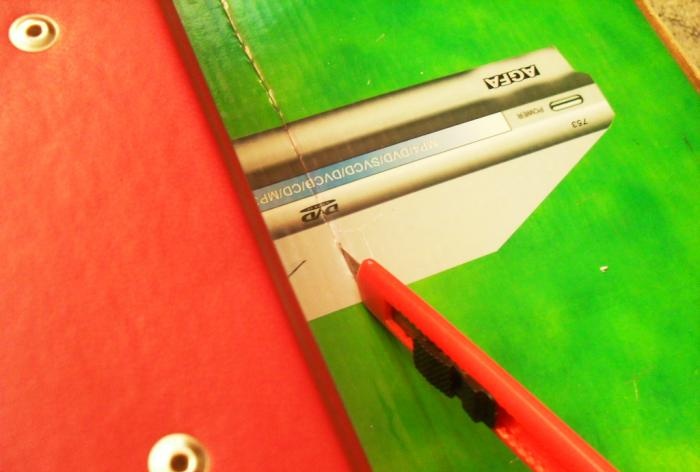
We cut the tank of the box at a greater distance, since these will be bends inward.
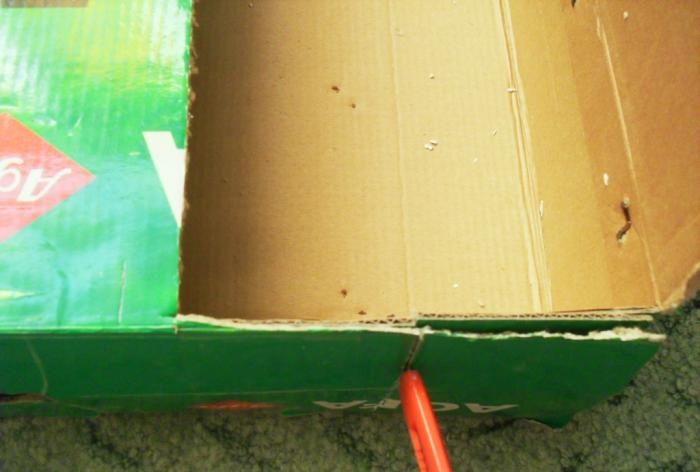
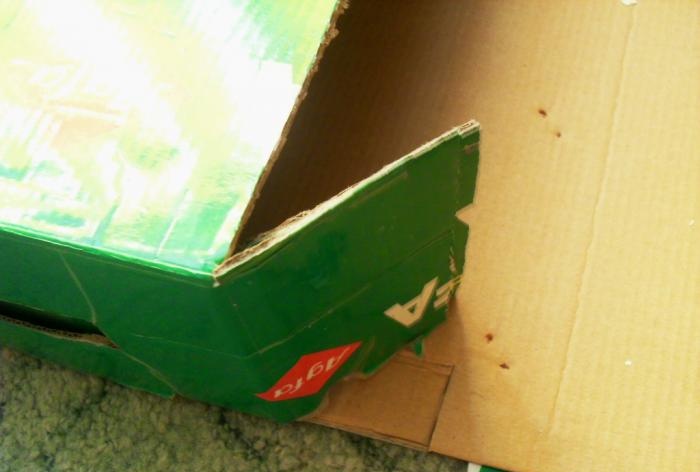
We cut the bottom of the box so that it can be folded upward (this will be the side of the portfolio box).
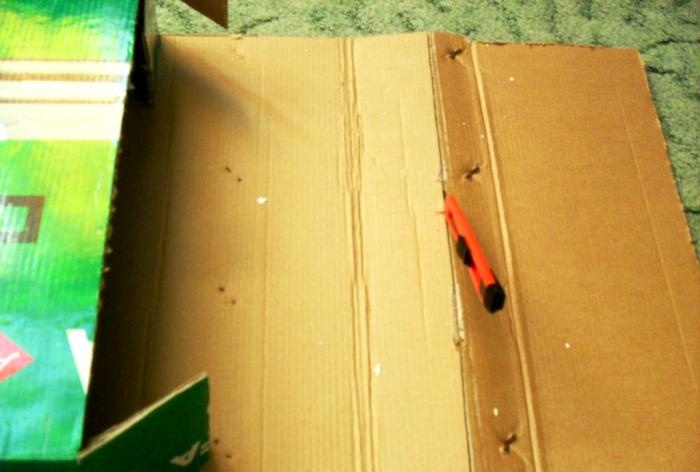
We cut off the top of the box from the edges and form the lid of the portfolio box.
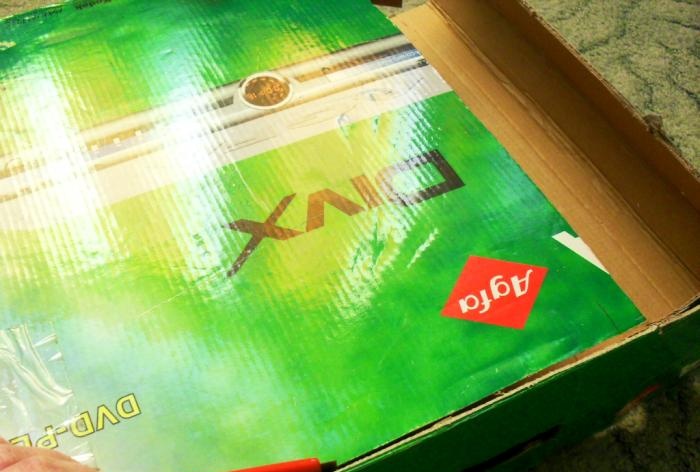
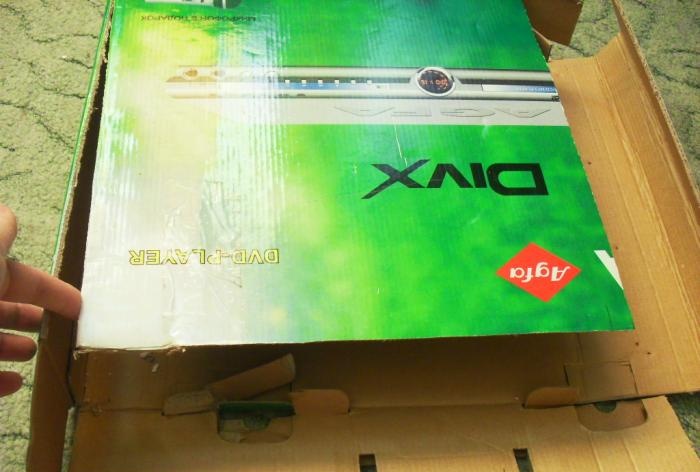
We bend the side part (the one that was cut larger) upward and fasten it with tape to the main body.
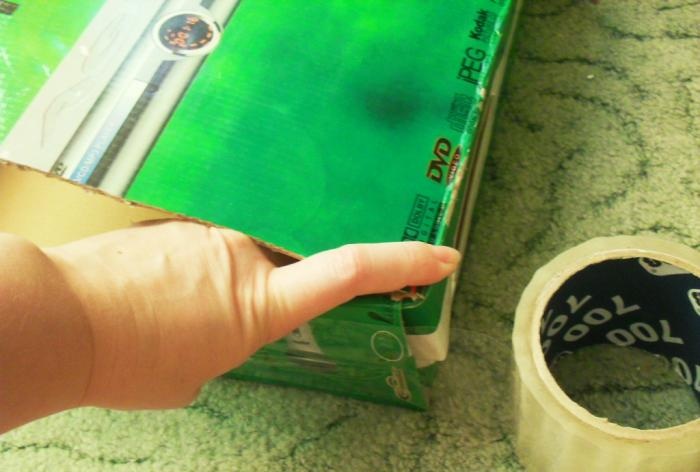
It turns out like this box with a lid - a closure.
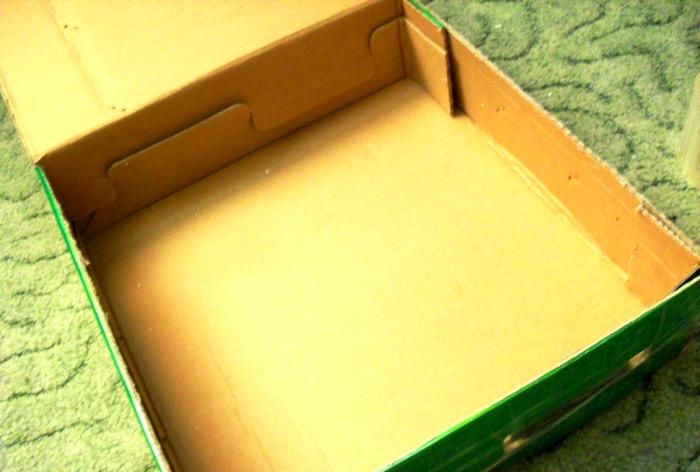
From the inside, along the entire perimeter of the box, we glue the side part with tape (to fasten all the bends).
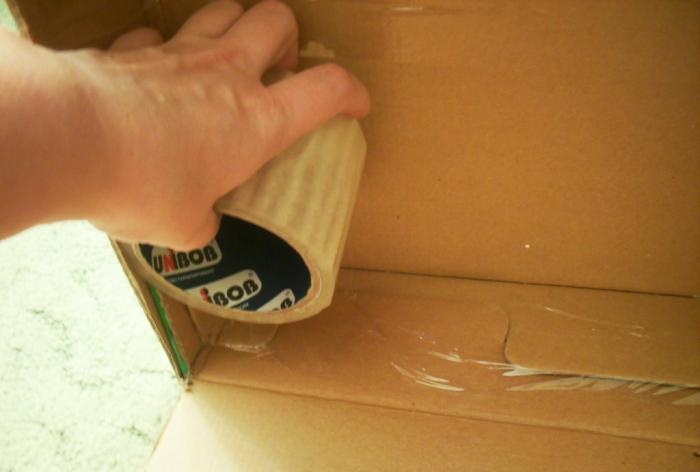
Stage six: mask the edges.
We cut a wide satin ribbon to fit the edges of the box.
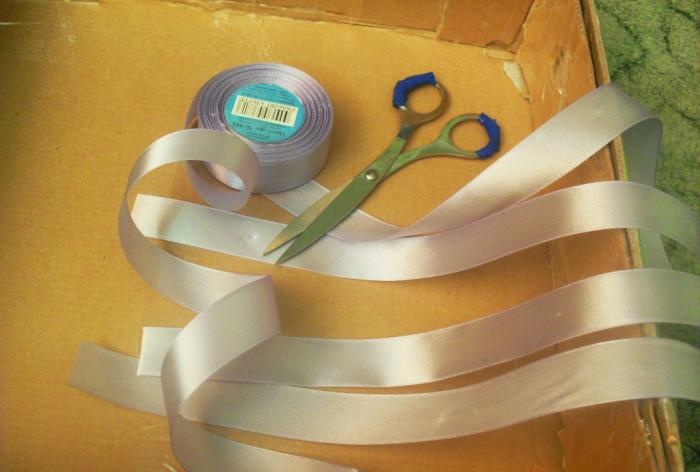
We secure it with a stationery stapler, wrapping it around the edge of the box. The main thing is to make sure that the tape is captured by the stapler on both sides of the bend.

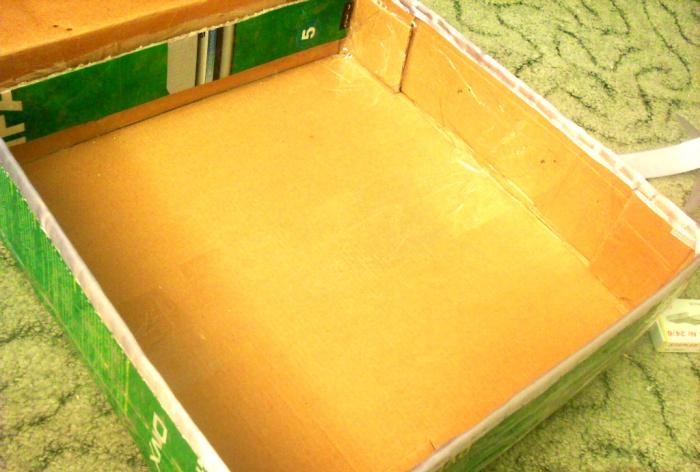
Apply “liquid nails” glue at the bend of the box lid.
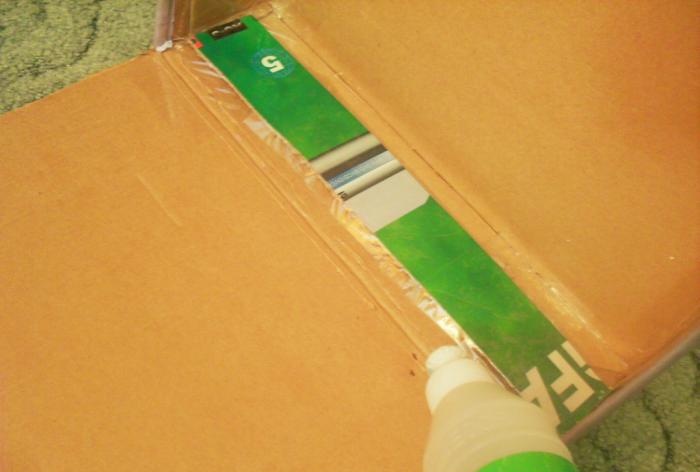
Glue a wide satin ribbon, leaving the edges free. Later they need to be folded onto the front side of the lid.
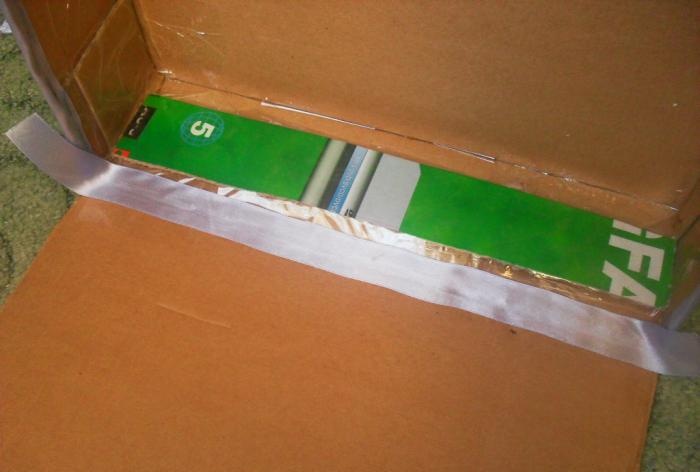
Similarly, we attach the satin ribbon to the edges of the lid with a spatter.
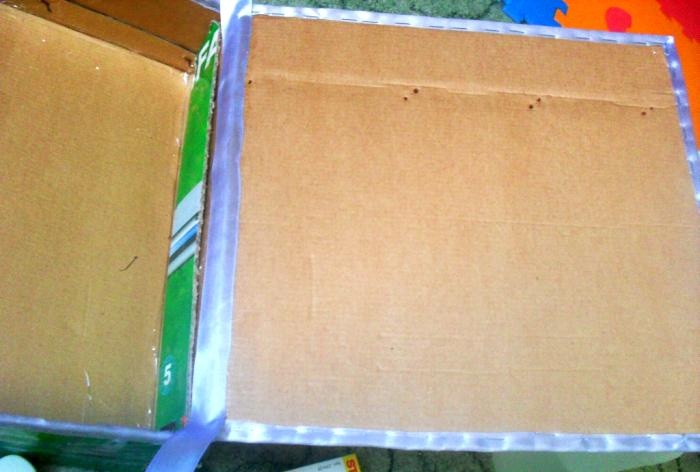
Seventh stage: create the texture.
Apply “liquid nails” glue to the bottom of the box with a fine mesh. If the bottom of the box is initially intact (not torn) and not taped, then instead of “liquid nails” you can use liquid PVA. Place crumpled pieces of toilet paper on top of the glue, pressing it into the glue and distributing it evenly along the bottom.
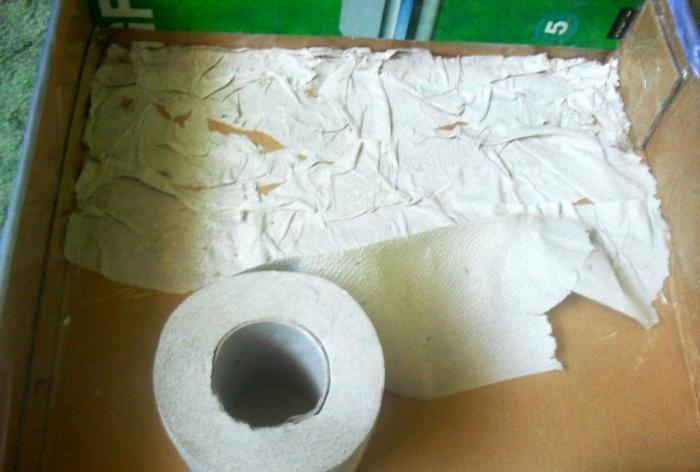
PVA tape will not secure the paper, so we apply “liquid nails” to the sides of the box. We decorate them with crumpled toilet paper. Carefully cover the staples on the satin ribbon with toilet paper.
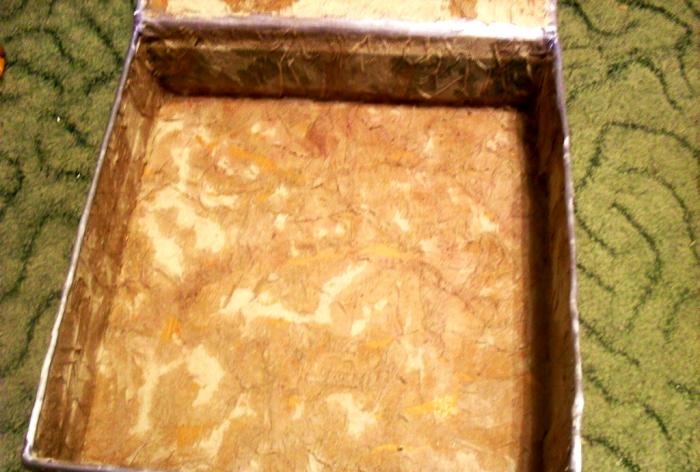
Using a stapler, we fasten a loop of narrow satin ribbon in the center of the edge of the lid from the inside. We cover the fastening points with tape.
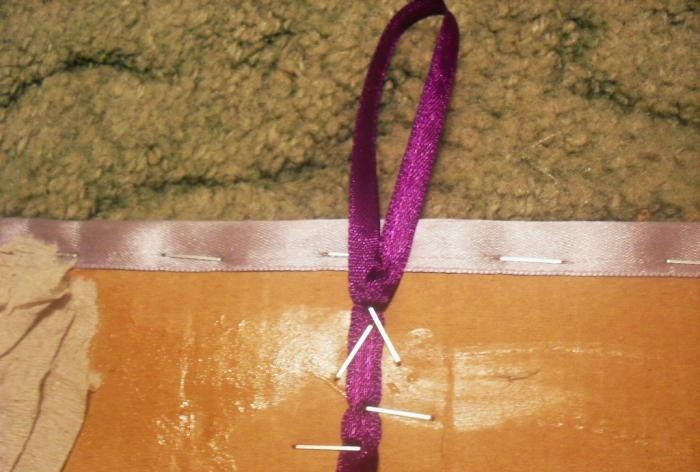
In the center of the box lid on both sides we glue rectangles with the name of the box and the surname and name of its owner. In order to preserve the recording, we seal the paper with tape. We cover the empty areas of the lid with crumpled toilet paper, after applying “liquid nails” glue.

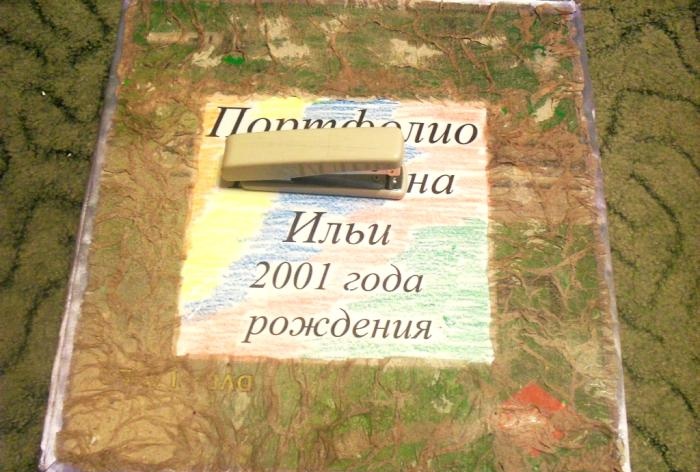
Eighth stage: fastener.
We thread aluminum wire into the leg of a large button.
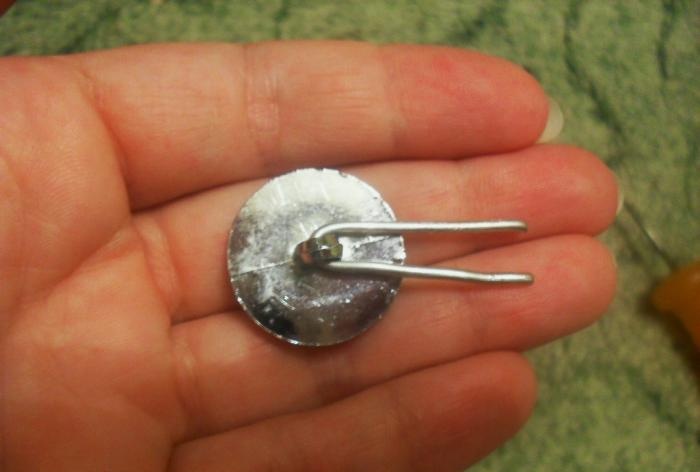
We lower the loop down and just above its end we make two through punctures in the side of the box (at a distance of 0.5 centimeters from each other).
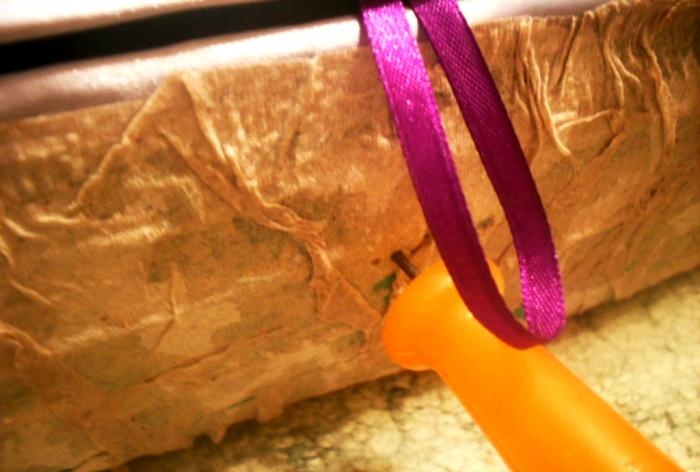
We insert the edges of the wire (buttons protruding from the leg) into the punctures and bend them from the inside of the box, pointing them towards each other.
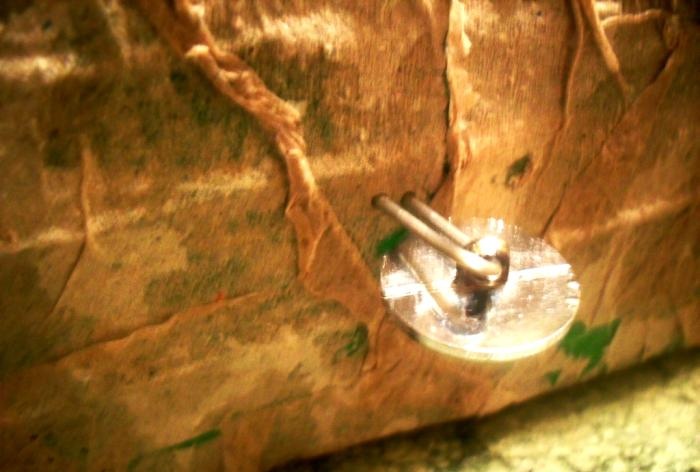
We hide the wire under toilet paper (applying a little glue and gluing a small piece).
Stage nine: paint.
Drying glue soaked through crumpled toilet paper. Using gold paint, carefully paint over all the folds of the toilet paper.
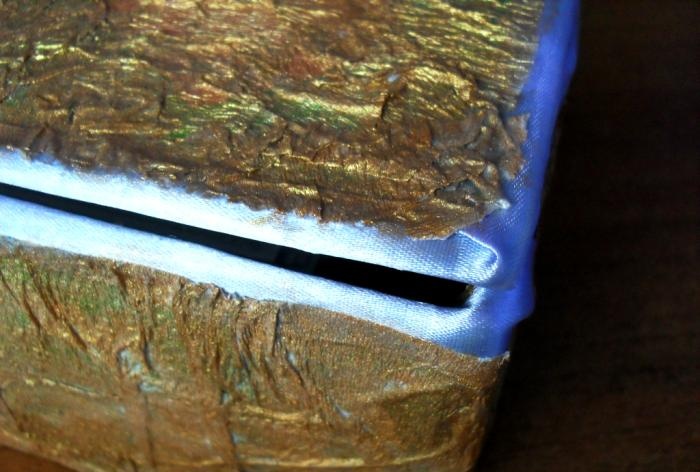
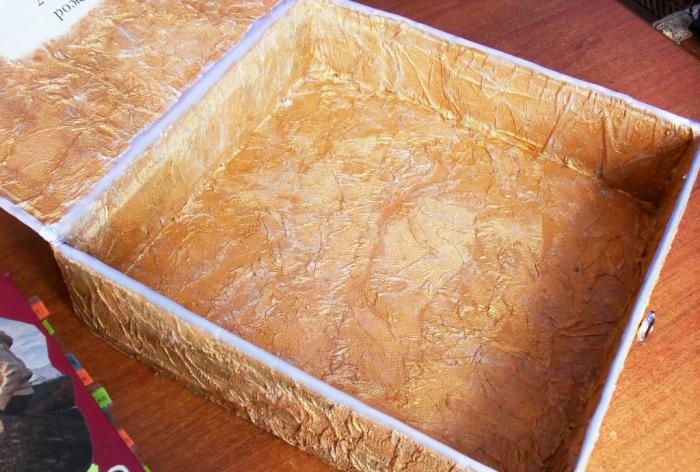
We solemnly place the portfolio in the box.
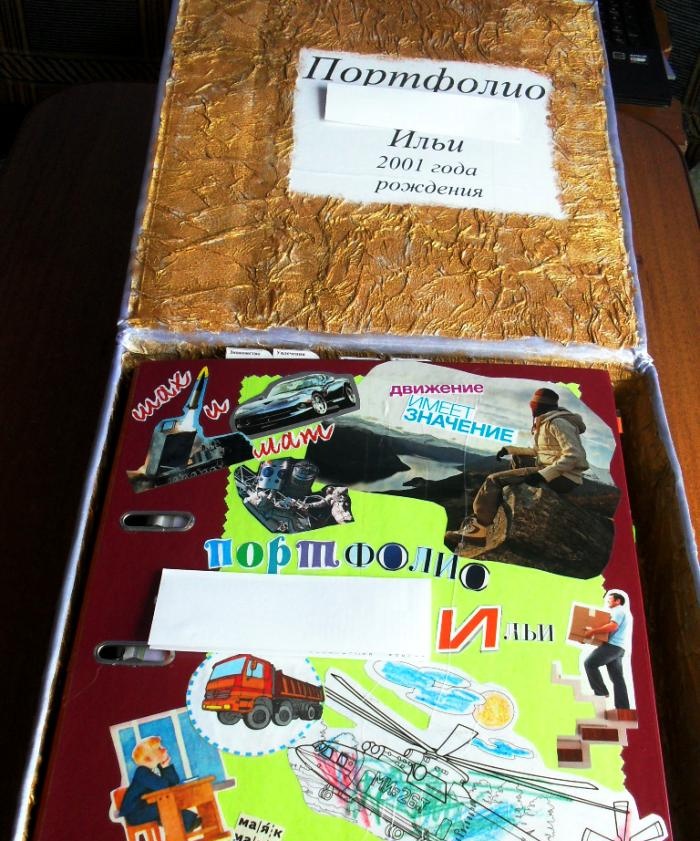
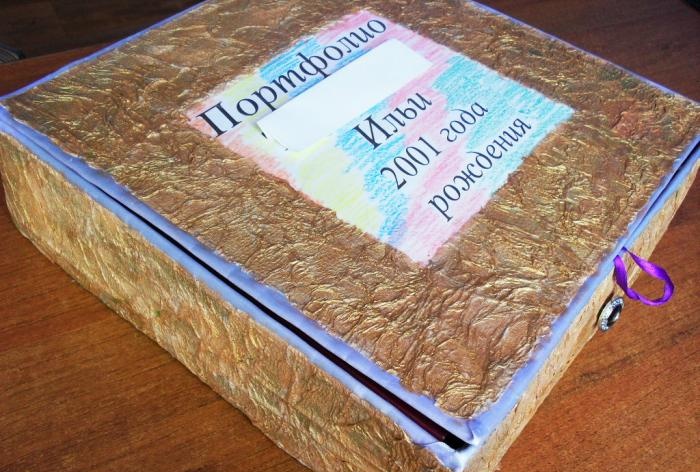
Now all your child’s achievements are not only neatly laid out and carefully stored. They can be proudly shown to relatives and guests as another masterpiece of the family archive.
Materials for work:
• folder - recorder – 1 pc.;
• double-sided colored cardboard – 12 sheets;
• whatman paper in A3 format – 1 sheet;
• PVA glue – 1 pencil;
• old box larger than the recorder – 1 pc.;
• wide stationery tape – 1 roll;
• button on the leg – 1 pc.;
• thin toilet paper – 1 roll;
• notebook with checkered sheets – 1 pc.;
• wide satin ribbon – 1 meter;
• narrow satin ribbon – 15 cm;
• pencil, stapler, paper cutting knife, liquid nails glue, awl, piece of wire, gold paint, curly scissors, brush.
Stages of work:
1. Portfolio.
First stage: create the “face” of the folder.
To create the front side of a portfolio folder, you can use anything: old books, an ABC book, postcards, magazines.

We decorate the edges of the colored sheet with curly scissors. We attach it to the folder with PVA glue.

We glue clippings, pictures, and inscriptions in random order.

In the central part we write the name of the folder, the last name and first name of its owner.

To preserve the integrity of the stickers, the entire collage can be covered with wide tape.
Second stage: we form title pages of sections.
The number of title pages and component sections of the portfolio is not established by certain standards, but to reveal all the child’s potentials, you can create the following: “let’s get acquainted”, “my hobbies”, “my pets”, “I’m in a team”, “my studies”, “documents” ", "my awards", "my works", "my creativity", "my impressions", "reviews", "electronic portfolio". To the back of the recorder folder we glue the “contents” with the names of the sections.

To give uniformity to colored clippings of different sizes that will decorate the title pages of the sections, we tear out the leaves from the notebook and decorate their edges with curly scissors.

We glue the name of the section onto colored cardboard and decorate it with pictures that match the meaning.

We put the finished title pages into the files.












Third stage: make dividing bookmarks.
From whatman paper in A3 format we cut strips 2-3 centimeters wide and a couple of centimeters longer than an A4 sheet.Using a glue cap, we make the cut strips semicircular on one side.

We print out the names of the portfolio sections and cut them.

We paste the names of the sections onto long strips.

We seal the names of the sections on the strips with tape on both sides.


Carefully cut the bookmarks, removing excess tape from the edges.

We glue a bookmark to the back side of the title page of the section (with PVA glue).


We glue the bookmark to the next title page, slightly shifting it so that it does not fall under the previous one (is not covered by it).

Stage four: systematize the inner world.
We put photos, documents, drawings, works, etc. into files. We insert files under the title page of each section.


In the “Let’s get to know each other” section, we indicate the child’s full name, date and place of birth, residential address, phone number, school, parents’ full name, and their phone numbers. Accompanying the text with photographs is welcome.
In the “My Hobbies” section, we glue photographs on cardboard sheets that tell about the child’s hobbies. To organize different pictures, you can use decorated leaves of a notepad as a backing for them.
In the “My Pets” section we place the child’s recorded stories about pets and his photographs with them.

The section “I’m in a team” is formed from cardboard sheets with photographs of the child pasted on them at various school events, hikes, excursions, etc.
The “My studies” section can consist of quarterly and annual grades (taken from diaries), tests and tests given to children.

In the “My Documents” section we insert files with diplomas, certificates, and diplomas confirming the child’s participation or victory in Olympiads, competitions, and marathons. You can also place newspaper clippings with articles about your child here.

There may not be a “My Awards” section if the child does not have medals, certificates, or certificates. In this section you can place scanned copies of the prizes received (for example, books, pens with the name of the competition, etc.).


The “My Works” section contains competitive essays, research papers, and archival materials collected for the family.
In the “My Creativity” section we place files with the child’s drawings, scanned copies of his crafts, applications and other leisure activities.

In the “My Impressions” section we put files with the child’s recorded stories about excursions, competitions, and trips.
The “Reviews” section may contain characteristics from the school, various sections and clubs, wishes and recommendations from friends and classmates, trip and expedition leaders.
The “Electronic Portfolio” section includes a flash drive with copies of presentations prepared by the child, photographs of his school and extracurricular life that are not included in the “I’m in a Team” section.
2. Box.
Fifth stage: forming the base.
We take a box larger in size than the folder-recorder.

Stepping back a couple of centimeters from the folder, we make a cut to the edges of the box.

We cut the tank of the box at a greater distance, since these will be bends inward.


We cut the bottom of the box so that it can be folded upward (this will be the side of the portfolio box).

We cut off the top of the box from the edges and form the lid of the portfolio box.


We bend the side part (the one that was cut larger) upward and fasten it with tape to the main body.

It turns out like this box with a lid - a closure.

From the inside, along the entire perimeter of the box, we glue the side part with tape (to fasten all the bends).

Stage six: mask the edges.
We cut a wide satin ribbon to fit the edges of the box.

We secure it with a stationery stapler, wrapping it around the edge of the box. The main thing is to make sure that the tape is captured by the stapler on both sides of the bend.


Apply “liquid nails” glue at the bend of the box lid.

Glue a wide satin ribbon, leaving the edges free. Later they need to be folded onto the front side of the lid.

Similarly, we attach the satin ribbon to the edges of the lid with a spatter.

Seventh stage: create the texture.
Apply “liquid nails” glue to the bottom of the box with a fine mesh. If the bottom of the box is initially intact (not torn) and not taped, then instead of “liquid nails” you can use liquid PVA. Place crumpled pieces of toilet paper on top of the glue, pressing it into the glue and distributing it evenly along the bottom.

PVA tape will not secure the paper, so we apply “liquid nails” to the sides of the box. We decorate them with crumpled toilet paper. Carefully cover the staples on the satin ribbon with toilet paper.

Using a stapler, we fasten a loop of narrow satin ribbon in the center of the edge of the lid from the inside. We cover the fastening points with tape.

In the center of the box lid on both sides we glue rectangles with the name of the box and the surname and name of its owner. In order to preserve the recording, we seal the paper with tape. We cover the empty areas of the lid with crumpled toilet paper, after applying “liquid nails” glue.


Eighth stage: fastener.
We thread aluminum wire into the leg of a large button.

We lower the loop down and just above its end we make two through punctures in the side of the box (at a distance of 0.5 centimeters from each other).

We insert the edges of the wire (buttons protruding from the leg) into the punctures and bend them from the inside of the box, pointing them towards each other.

We hide the wire under toilet paper (applying a little glue and gluing a small piece).
Stage nine: paint.
Drying glue soaked through crumpled toilet paper. Using gold paint, carefully paint over all the folds of the toilet paper.


We solemnly place the portfolio in the box.


Now all your child’s achievements are not only neatly laid out and carefully stored. They can be proudly shown to relatives and guests as another masterpiece of the family archive.
Similar master classes
Particularly interesting
Comments (1)



